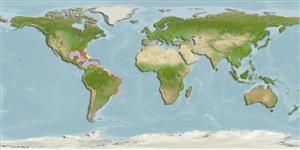Common names from other countries
Environment: milieu / climate zone / depth range / distribution range
Écologie
; profondeur 0 - 90 m (Ref. 97531). Tropical; 37°N - 31°S, 100°W - 28°W
Distribution
Pays | Zones FAO | Écosystèmes | Occurrences | Introductions
Western Atlantic Ocean; Known from North Carolina, USA to Gulf of Mexico, Antilles and the Caribbean south to Santa Catarina, Brazil.
Length at first maturity / Taille / Poids / Âge
Maturity: Lm ? range ? - ? cm
Dwells in reef and seagrass habitats in Belize. Forms facultative associations with sea anemones (Ref. 128695). Epibiotic.
Life cycle and mating behavior
Maturité | Reproduction | Frai | Œufs | Fécondité | Larves
Members of the order Decapoda are mostly gonochoric. Mating behavior: Precopulatory courtship ritual is common (through olfactory and tactile cues); usually indirect sperm transfer.
Bisby, F.A., M.A. Ruggiero, K.L. Wilson, M. Cachuela-Palacio, S.W. Kimani, Y.R. Roskov, A. Soulier-Perkins and J. van Hertum. 2005. (Ref. 19)
Statut dans la liste rouge de l'IUCN (Ref. 130435)
statut CITES (Ref. 108899)
Not Evaluated
Not Evaluated
Utilisations par l'homme
Pêcheries: commercial
| FishSource |
Outils
Plus d'informations
Taille/Âge
Croissance
Longueur-poids
Longueur-longueur
Morphologie
Larves
Abondance
Sources Internet
Estimates based on models
Catégorie de prix
Unknown.
